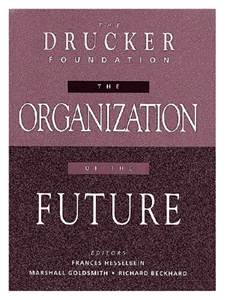"The Organization of the Future," edited by Frances Hesselbein, Marshall Goldsmith and Richard Beckard
The Organization of the Future, edited by Frances Hesselbein, Marshall Goldsmith and Richard Beckhard (397 pages, Jossey-Bass Publishers, 1996)
(originally published by Booz & Company) If you read enough, you begin to realize that management theories are a lot like chafing dish food in big hotels: they resemble something you used to find exciting, but they're warmed over and tired. You find yourself surveying the terrain, looking for zesty flavors and all you see is beurre blanc. It's impossible to tell if the problem is your jaded palate or the food.
If you read enough, you begin to realize that management theories are a lot like chafing dish food in big hotels: they resemble something you used to find exciting, but they're warmed over and tired. You find yourself surveying the terrain, looking for zesty flavors and all you see is beurre blanc. It's impossible to tell if the problem is your jaded palate or the food.
It is not that The Organization of the Future, a collection of essays on organization and leadership issued by Jossey-Bass Publishers with the imprimatur of the Peter Drucker Foundation, does not serve a useful purpose. As one of the contributors notes, consultants talk as if the new age of management — of flatness, fluidity and flexibility — is already under way, when anyone who keeps up with companies knows that most of them are getting along perfectly well on their bad old hierarchical values.
There is, then, a need for a primer, and some of the book's authors were present at the creation of the current paradigm: C.K. Prahalad, Chris Argyris, R. Roosevelt Thomas Jr., Rosabeth Moss Kanter and Charles Handy. They and the other authors return again and again (more often than is strictly necessary) to the same themes: The Organization of the Future will be lean but not mean. Visionary C.E.O.'s will help transform the nature of the contract between employer and employee, turning it from an adversary relationship to a model of cooperation that benefits everyone. Employees may have to work harder, but they'll also work smarter so they will be able to maintain a balance between their work and their lives at home. They will be empowered.
Organizations of the future will nurture continuous learning: for employees, to keep them "employable," as well as for the organization itself, to keep it evolving. Organizations will be diverse, taking advantage of a much wider pool of talent than they have traditionally. And organizations will be flexible, perhaps even fungible, changing form to respond to changes in the external environment.
The reader can pick up the drift quickly by plunging into Ms. Kanter and Mr. Prahalad. Ms. Kanter puts her mantra — get people back to the heart of the organization — in a global perspective. Mr. Prahalad takes on the thornier problem of how to get past the vision of a 21st century organization to the reality, and the reality is that it is very hard to get people, especially people, like managers, who have a stake in the status quo, to change. His essay, "The Work of New Age Managers," provides some guidelines.
Bottom-line-oriented readers curious about but unfamiliar with the new management paradigm may find some of the touchier-feelier essays a little unnerving. Nathaniel Branden, whose biographical notes say he "has been described as the father of the self-esteem movement," counsels senior executives, "When you talk with your people, be present with the experience." And always look them straight in their third eye. In the next chapter, Deepak Sethi, who runs AT&T's high-potential manager development program, covers some of Mr. Branden's ground, but with both feet planted on terra firma. Members of a high-performance culture need respect, responsibilities and resources, permission to take risks, rewards and recognition, positive relationships and role models and time for renewal. These things lead to high self-esteem, which feeds back into high performance. Common sense is so elegant.
The Organization of the Future, though it mulls at length over leadership, does no better or worse than any of the dozens of other books on the subject at getting to what leadership is or how to cultivate it. Leadership remains like pornography: you may not be able to define it, but you know it when you see it. There is a good chapter, by Marshall Goldsmith, one of the book's editors, on keeping talented employees, a subject much ignored in corporate America. Companies may feel they control a buyer's market in talent, but really good people still have considerable mobility, and the old image of success — lifetime employment at a big company — no longer automatically attracts the best.
Although the book refers several times to the digital age and the Internet, there is an odd lack of effervescence over the possibilities of a wired future. Pierre Everaert, chief executive of the Dutch company Koninklijke Ahold, does observe, interestingly, that organizations will have to match their management of human capital to the "tempo and timing" of the outside world. "Computers have a novelty span of six months at the most. Software changes by the day.... Time to market and time to money have been drastically cut." It's left to Charles Handy to speculate on the impact of the organizations that will grow in cyberspace. Managers, who have traditionally done their managing during "face time," will have to learn new, as-yet-undefined skills to cope with employees who may only be connected by fiber optics and I.S.D.N. lines. Unfortunately, Mr. Handy doesn't do much more than raise the issue.
On this and other issues, climbing a little further out on the limb would have taken The Organization of the Future beyond the primer stage. ![]()
Reprint No. 97210


